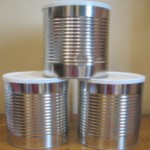Factor #1: The Temperature  Temperature has more to do with how long well dried foods store than anything else. The USDA states, "Each 5.6 C. (10.08F) drop in temperature doubles the storage life of the seeds." Obviously, there is a limit as to how far this statement can be taken. However I expect it basically holds true from room temperature down to freezing. No doubt, the inverse could also be considered true. "Each 5.6C. (10.08F) rise in temperature halves the storage life of seeds." This theory holds true for non-garden seeds as well.
Temperature has more to do with how long well dried foods store than anything else. The USDA states, "Each 5.6 C. (10.08F) drop in temperature doubles the storage life of the seeds." Obviously, there is a limit as to how far this statement can be taken. However I expect it basically holds true from room temperature down to freezing. No doubt, the inverse could also be considered true. "Each 5.6C. (10.08F) rise in temperature halves the storage life of seeds." This theory holds true for non-garden seeds as well.
Storage Life Differences
Depending on Temperature
 Foods packed in air don't store as well as in oxygen free gasses. This is because air contains oxygen which oxidizes many of the compounds in food. Food storage companies have a couple of different processes for removing the oxygen:
Foods packed in air don't store as well as in oxygen free gasses. This is because air contains oxygen which oxidizes many of the compounds in food. Food storage companies have a couple of different processes for removing the oxygen:

 To get the best storage life out of your product it must have a hermetic (air tight) seal. Containers that do this well are
To get the best storage life out of your product it must have a hermetic (air tight) seal. Containers that do this well are
 Temperature has more to do with how long well dried foods store than anything else. The USDA states, "Each 5.6 C. (10.08F) drop in temperature doubles the storage life of the seeds." Obviously, there is a limit as to how far this statement can be taken. However I expect it basically holds true from room temperature down to freezing. No doubt, the inverse could also be considered true. "Each 5.6C. (10.08F) rise in temperature halves the storage life of seeds." This theory holds true for non-garden seeds as well.
Temperature has more to do with how long well dried foods store than anything else. The USDA states, "Each 5.6 C. (10.08F) drop in temperature doubles the storage life of the seeds." Obviously, there is a limit as to how far this statement can be taken. However I expect it basically holds true from room temperature down to freezing. No doubt, the inverse could also be considered true. "Each 5.6C. (10.08F) rise in temperature halves the storage life of seeds." This theory holds true for non-garden seeds as well.
Constant Storage Storage life
Temp in degrees F In Years
---------------- ------------
37.6 - - - 40
48.4 - - - 30
59.2 - - - 20
70.0 - - - 10
80.8 - - - 5
91.6 - - - 2.5
102.4 - - 1.25
Note: the above chart is not for a specific food but shows the relationship between temperature and storage life.The bottom line is even with the very best packaging methods, if you are planning on storing your food in a warm environment, it will only last a fraction of the time it would last if stored in a cool, dry place. It is important you also find a place where the temperature remains constant. Frequent temperature changes shorten storage life. If you don't have a cool place for your food storage, plan on rotating your storage quickly enough to prevent food loss. Factor #2: Product Moisture Content By looking at the USDA nutritional tables, dry beans, grains, and flours contain an average of 10% moisture. Although it is very difficult and unnecessary to remove all moisture from dry foods, it is imperative that any food be stored as dry as possible. Foods with excess moisture can spoil right in their containers. This is an important consideration when packing food with dry ice as moisture condenses and freezes on the outer surface of the dry ice. For long term storage, grains should have a moisture content of 10% or less. It is difficult to accurately measure this without special equipment. Factor #3: Atmosphere the Product is Stored in
 Foods packed in air don't store as well as in oxygen free gasses. This is because air contains oxygen which oxidizes many of the compounds in food. Food storage companies have a couple of different processes for removing the oxygen:
Foods packed in air don't store as well as in oxygen free gasses. This is because air contains oxygen which oxidizes many of the compounds in food. Food storage companies have a couple of different processes for removing the oxygen:
- Displacing the oxygen: This is done by purging out all the air in the product with an inert gas. Nitrogen is almost always used because it is the most inert gas known. People doing their own packing occasionally use dry ice which gives off carbon dioxide gas, and probably works just about as well. Rainy Day Foods/Walton Feed no longer use this method as the oxygen absorbers do a better job.
- Absorb the oxygen: Oxygen absorber packets do just that. Air contains about 78% nitrogen and 21% oxygen, leaving about 1% for the other gasses. If the oxygen is absorbed, what remains is 99% pure nitrogen in a partial vacuum.

 To get the best storage life out of your product it must have a hermetic (air tight) seal. Containers that do this well are
To get the best storage life out of your product it must have a hermetic (air tight) seal. Containers that do this well are
- #10 Cans
- Seal-able food storage buckets
- Seal-able food quality metal or plastic drums.

